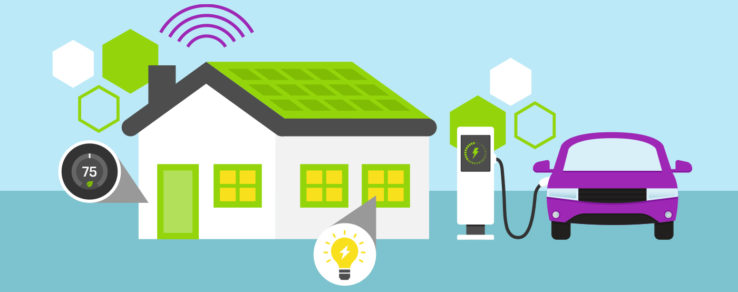Your customers want to save energy; they just might not know how. By educating customers about energy waste and showing them how they can save, your energy utility can help customers take advantage of energy-saving programs and products. More than ever, there is a growing need for energy efficiency education.
Many customers don’t realize the strong impact that making energy-efficient choices has on both a person’s daily life and their community. According to Energy.gov, “Energy efficiency is one of the easiest and most cost-effective ways to combat climate change, reduce energy costs for consumers, and improve the competitiveness of U.S. businesses.” Energy efficiency is also a very important component in achieving net-zero emissions.
By increasing energy efficiency education, customers will have a better understanding of how their energy-efficient choices can:
- Save money
- Increase the resilience and reliability of the electric grid
- Provide environmental, community and health benefits
Energy Efficiency Education for Customers
The first step to converting customers is educating them. Think about who your utility is trying to reach and what their interests and needs are. For example, residential and business customers are very different. What resonates with one doesn’t necessarily resonate with the other.
Business customers, for example, care about reducing energy usage and operating costs while keeping productivity high. Residential customers, on the other hand, may care more about simple, effective ways to reduce their home energy bills without sacrificing comfort. Consider segmenting your communications so you can reach different customers with different energy efficiency campaign messages.
Energy Efficiency Education Examples
Energy efficiency doesn’t have to be difficult for customers. Duke Energy offers free home energy assessments where an energy professional will visit a home and perform a walk-through. They will then give the customer a detailed report showcasing how their home could be more energy efficient and ways they can lower their energy bill.
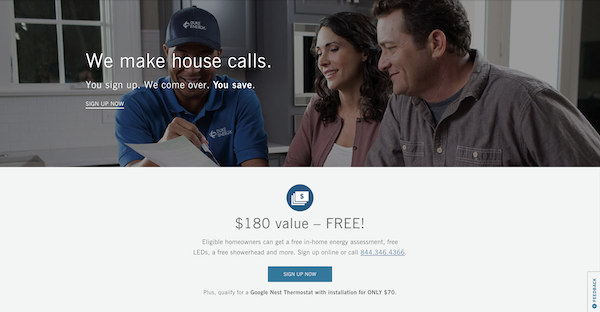
PSEG Long Island offers an online home energy analyzer that is free for customers to use. It’s similar to a home walk-through, but instead, customers can input information about their home themselves and have their energy efficiency calculated immediately. They can also reuse the analyzer multiple times to test changes to their home and see the results. In the end, customers are made much more aware of the impact on their energy bills.
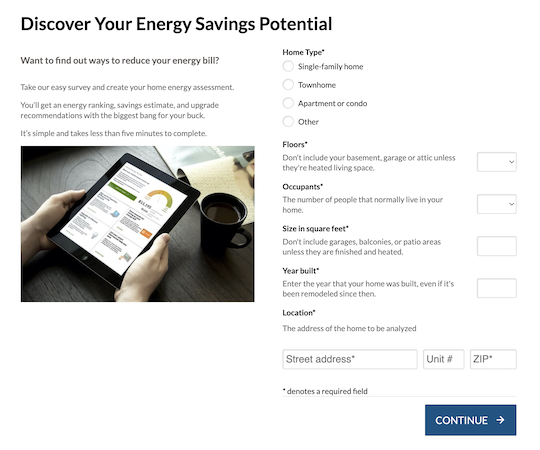
Additionally, PSEG Long Island promotes seasonal energy-saving opportunities with energy efficiency campaigns. In the summer, the utility developed an email campaign that promoted chargeable electric lawn equipment.
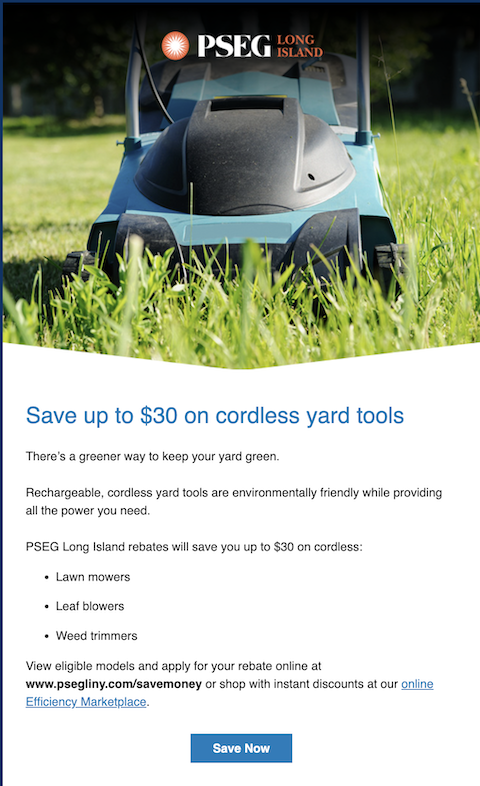
The utility also promoted “National Cut Your Energy Cost Day” on social media by sharing advice for cutting energy costs. It’s important to stay a few steps ahead of your customers in anticipating their needs.
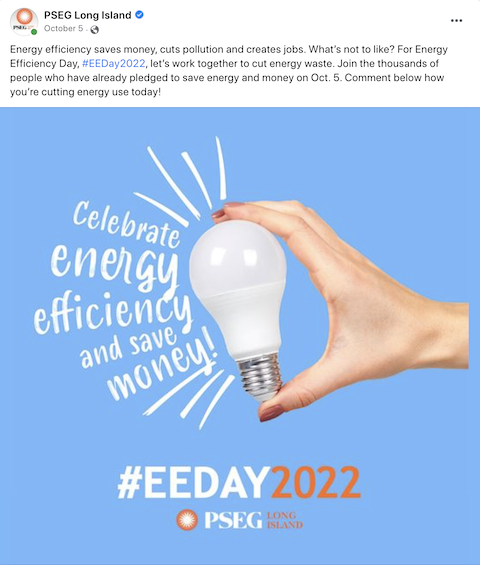
There’s No Place Like an Energy-Efficient Home
When it comes to energy efficiency education, residential customers tend to be more open to receiving advice or promotions, simply because they have the time to consider making purchases or behavioral changes. In comparison, time-starved business customers may see these conversations as distractions in their busy day.
“Owners and other decision-makers are busy trying to keep their business running, usually getting their hands dirty right alongside their employees,” observed the Association of Energy Services Professionals. “And as energy efficiency program implementers, here we come, knocking on their doors out of the blue, wanting an hour of their precious time to conduct an energy audit.”
When communicating to residential customers about energy efficiency awareness, there are a few topics that resonate most:
- Self-serve: Customers want the ability to take things into their own hands and control their energy use. By sharing energy efficiency education tips and recommending things they can do themselves, such as replacing traditional lightbulbs with LEDs or adding ENERGY STAR® appliances to their kitchen, they are more responsive to making these changes.
- Money: A big motivation for purchasing energy-efficient products is cost savings. Help residential customers crunch the numbers with an energy analyzer tool or calculator that shows exactly what their bill would be if they made these investments.
- Property value: The more energy efficient a home is, the higher its property value, which means more money for customers. In fact, according to The Guardian and an Energy Saving Trust survey, 70% of homebuyers would consider negotiating the cost of a property if it was inefficient.
Even though homeowners are often the ones who can make large investments in energy efficiency, your energy utility shouldn’t forget about renters. This customer segment is just as concerned about lowering their energy costs as homeowners, if not more. Ensure you have a strategy in place that shares relevant energy efficiency education tips with renters.
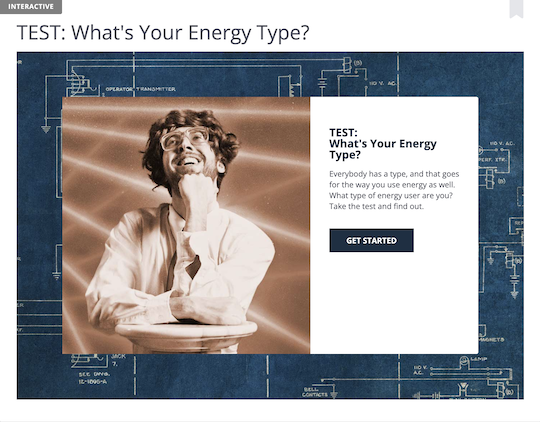
Content marketing is a powerful tool in energy efficiency education. By teaching customers about energy efficiency in fun, engaging ways, they are more likely to make the switch. One example used by Questline Digital clients is the quiz “What’s your energy type?” which prompts customers to think about how they use energy in their day-to-day life. Once they understand their energy style, it provides more opportunities for your utility to promote energy efficiency awareness.
How Peer Pressure Can Create Customer Interest in Energy Efficiency
Another way to reach your residential customers is through friendly neighborhood competition. We’re serious — social norms are a stronger motivator than even your best promotional message.
According to research by the Harvard Business Review, people often use less energy when they think their neighbors care about the environment. When residential customers were told how much energy they consumed and how much energy their neighbors used, customers reduced their energy use by 1% to 2% per year.
“Surprisingly, what matters more than one’s own attitudes and beliefs — how concerned we are with our own energy use and the environment — is whether we believe our neighbors view saving energy as important to saving the environment,” the report found. So rather than always pushing “go green” messages directly on customers, consider taking an indirect route and sharing how their neighbors are making changes instead.
Business Customers and Energy Efficiency
Compared to residential outreach, communicating to business customers about energy efficiency education needs to be much more succinct and focused on two benefits: money and brand reputation.
Like residential customers, money is a top concern for business customers. However, this audience sees savings in a different light. Instead of simple lightbulb swaps, business customers want to know how to save the “big bucks.”
Share energy efficiency campaigns about rebate programs on equipment these customers may often use or need to purchase, or provide side-by-side comparisons of the energy performance (and savings) of key products. For example, illustrate the cost-savings of an electric forklift versus a conventional forklift for warehouse facilities, or electric fleets versus gas-powered fleets for delivery vehicles. By focusing on the equipment that matters to business customers, you can pique their interest.
When it comes to brand reputation, we all know that simple reviews or bad comments can make or break a business in the digital age. Creating a positive image is imperative, especially when it comes to sustainability and energy efficiency. In fact, according to a study by IBM and the National Retail Federation, “Nearly 70% of consumers in the U.S. and Canada think it is important that a brand is sustainable or eco-friendly.”
Business customers need to realize that their public image is just as important as their product. By implementing energy-saving processes or switching to efficient equipment, they could not only reduce operating expenses but increase revenue through customer appreciation and an eco-friendly reputation.
Guide Your Customers to Energy Savings
Building energy efficiency awareness comes down to what your customers need. Every customer is unique — it’s up to your energy utility to identify what matters to them and provide relevant solutions.
Customers are interested in saving energy and willing to make the switch, but your energy utility needs to educate them on the efficient products and services that will make an impact and help them save.

